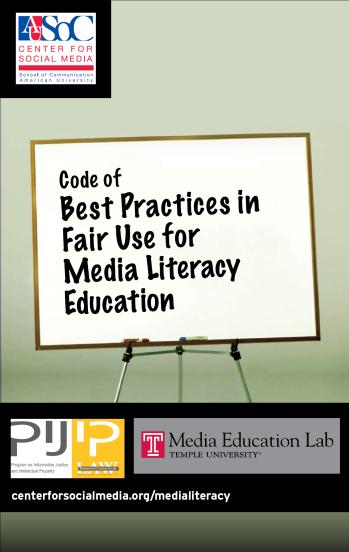This curriculum is designed for educators interested in exploring copyright and fair use in relation to the Code of Best Practices in Fair Use for Media Literacy Education. Please read the Code before using these curriculum materials. You can download the full curriculum where it says "Attached Files" at the top of this page.
 I. Overview, Context and
Background. Learn why it's important for educators to
explore issues of copyright and fair use with students.
I. Overview, Context and
Background. Learn why it's important for educators to
explore issues of copyright and fair use with students.
II.
Lessons
1. Understanding Copyright. Learn about how copyright law protects both the rights of owners and the rights of users in order to promote creativity for the good of society.
2. The Cost of Copyright Confusion. Explore how lack of knowledge about copyright and fair use negatively affects teaching and learning.
3. Defining and Applying Fair Use. Learn more about Section 107 of the Copyright Act and see how fair use and transformativeness applies to the practice of teaching and learning.
4. The Five Principles. Examine the Code of Best Practices in Fair Use for Media Literacy Education to learn how educators use it as a tool in making decisions about the use of copyrighted materials to promote critical thinking and communication skills.
5. Advocacy. Learn how ideas about copyright are in transition as a result of changes in communication technologies and appreciate how the "best practices" model enables creative communities to develop a robust interpretation of fair use.
III. Resources for Learning More.Books, videos and articles for extending your learning.
Each lesson contains activities and readings for three different levels: (A) high school; (B) undergraduate; and (C) graduate. NOTE: Lesson plans focus on activities for high school and undergraduate learners.
This project was funded by the John D. and Catherine T. MacArthur Foundation.